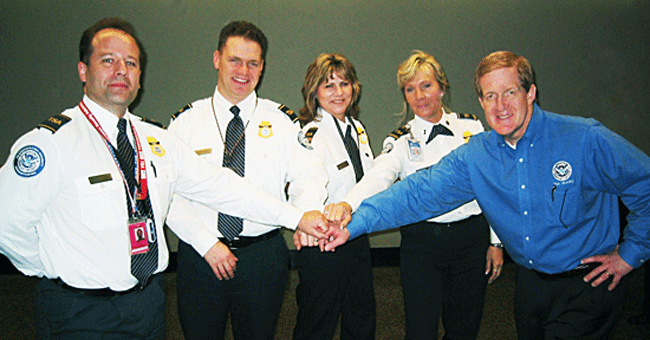 Dateline-Phoenix,
Arizona
Dateline-Phoenix,
Arizona
|
TSA
Unveils Team Approach
 TSA
Administrator Kip Hawley(far right) and TSA Team: TSA
Administrator Kip Hawley(far right) and TSA Team:
“Picking out one singular scenario
and calling for 100% measures and devoting resources to just that
means you run out of resources.” |
Yesterday
may be remembered as the day that U.S. air cargo security received the
clearest message yet that major change is afoot at the Transportation
Security Administration (TSA) as that agency’s top administrator
Kip Hawley came forward with a plain speaking keynote address providing
a rousing start while naming names that air cargo can talk to up close
and personal as new security modes are developed.
Hawley spoke at Air Cargo 2007 taking place
this week (March 11-13) in Phoenix Arizona.
Air Cargo 2007 is the annual trade show
and conference for the Air and Expedited Motor Carriers Association (AEMCA),
the Airforwarders Association (AfA), and the Express Delivery & Logistics
Association (XLA).
“The question of security is not a
question of if the industry can work in this environment, but can all
the players connect with the government for real sustainable cooperation
measures?
The first part of partnership is forming
a connection.
You need to know who you can talk to about
moving the ball forward.
Who is at the top of the (TSA) food chain?
John Sammon works on the transportation
network group.
At TSA, we have an office of security, which
works with airlines, law enforcement who works with marshals and the network
group.
The network group is in the business to
work with operators and hear if what we are doing is actually providing
real security value.
John Sammon has 30 years in the cargo industry
on the rail side with CSX.
When we hired John, we wanted someone who
understood freight operations and could connect with government experts
to bring a lifetime of understanding to the process, while also understanding
those on the cargo side.
We’re also happy to have Ed Kelley,
as general manager for air cargo, who is the point person for air cargo.
Ed is the air cargo gatekeeper.
He served at Hellman and UPS and also “gets
it”.
So now TSA has senior leadership who can
connect with you at your level.
One of our big problems as an industry is
to stay focused and realize it’s a real thing we are involved.
From a network approach, we look at the
supply chain both horizontally and vertically.
Horizontal looks evaluate what is in the
box and how did it get here?
Vertical is what happens at the airport,
what measures do we have at the airport to ensure security via canines
and other methods at the airport.
How do we look at our security?
It’s connecting on what’s there.
What is already there is a robust intelligence
community and information – those components are conducted and share
information.
TSA is focused on creating layers, flexibility
and dynamic approaches to cargo.
We don’t want to present a static
target.
Instead, we introduce new ways to deal with
cargo.
At each airport we have folks moving around
to cover a wired area.
We are not about focal point security. Focal
point security is a real danger for our homeland security policy –
the concept, for example, is screening 100% of airport employees.
Picking out one singular scenario and calling
for 100% measures and devoting resources to just that means you run out
of resources.
We need to move away from that approach
that is compliance oriented.
So if a 100% screening offers fixed compliance
based security, we need an alternative security policy that is thinking
and adapting to the environment.
TSA is looking to give discretion to front
line workers.
Inspectors are looking to make sure operators
are practicing security.
We are engaged and have a shared responsibility.
The inspectors believe that and are working
towards that goal—not to get a compliance violation.
Our primary goal is not to shut people down
and grade people.
You can help by embracing inspectors and
accepting that.
Make them your partner.
Other piece is international. Recently we
came up with one security system across U.S. and Canada, and now also
with the EU and Australia and Japan. This was the first time we negotiated
a security regime ahead of issuing a plan to deal with exchanging information
and science to deal with this particular security threat.
This is the first time we have one single
approach across lines – air cargo is next. We want a harmonized
approach throughout North America and hopefully the EU as well.
Also, we are working within DHS to make
it a single agency and work with CBP to deal and learn with CTPAT and
not reinvent programs, but integrate them into one solution.
IDs – we want to know whom you are
picking the package up from.
We are trying to secure the supply chain
and are working on how to do this without disrupting the chain.
Regardless of how that policy, we need to
engage with you and understand the experiences and put policies into place
that work.
“We all have responsibility to secure
air cargo.”
|



